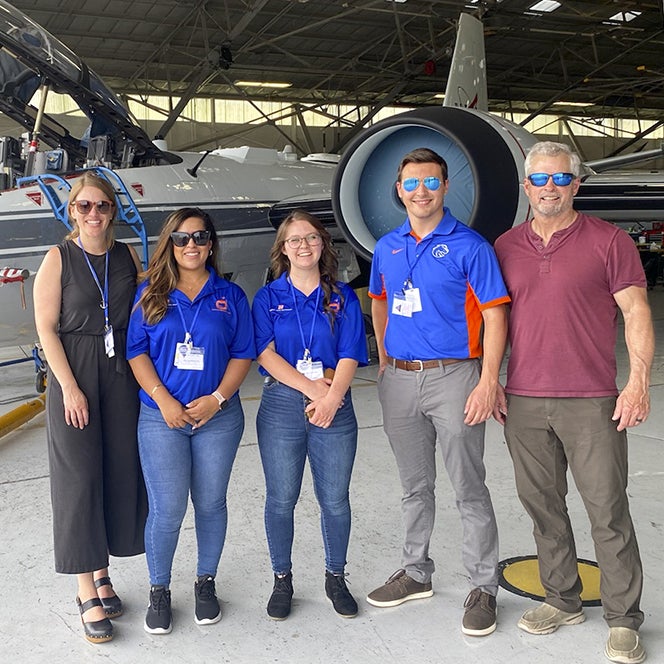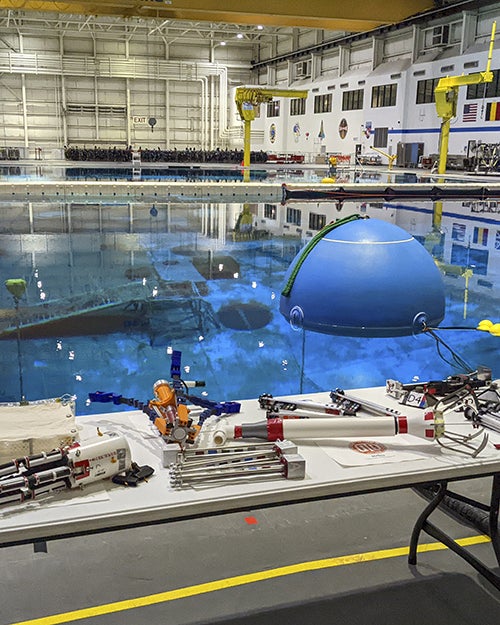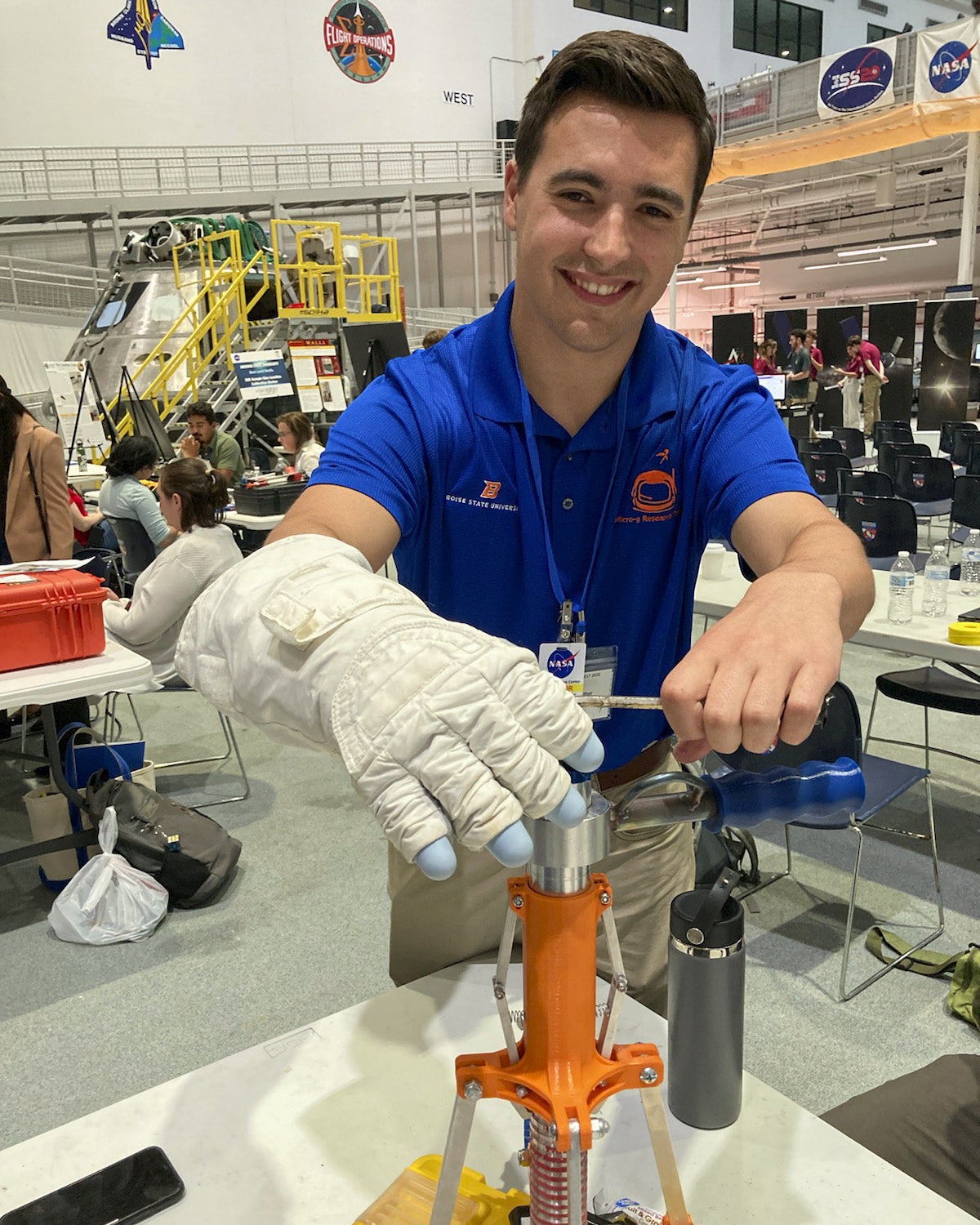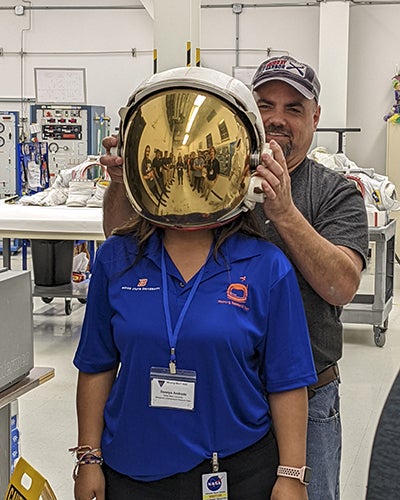
In June 2022, three Boise State students from the NASA Micro-g Neutral Buoyancy Experiment Design Team (Micro-g NExT) arrived at the NASA Johnson Space Center Neutral Buoyancy Laboratory to see their device, “The CLAW,” tested by NASA scientists.
This year’s challenge was to “design a sample marker for astronauts to deploy on the lunar surface. The design should focus on ease of use with limited hand dexterity and body positioning in a spacesuit. The purpose of the sample marker is to provide real-time data about a sample or rock to the scientists back on Earth.”
In true Bronco fashion, Boise State’s team, guided by Distinguished Educator in Residence and retired astronaut Steve Swanson, set about engineering, designing and building a tool to do exactly that. Soren Witter, DeAnna Andrade, and Ainsley Iwersen represented Boise State at the Johnson Space Center.
Andrade is a senior mechanical engineering major who anticipates graduating in December 2022. She was born in Puerto Vallarta, Mexico and grew up in Boise. Witter is a senior and will graduate in spring of 2023. He is also majoring in mechanical engineering, and hails from Steilacoom, WA. Iwersen is a junior transferring to Texas A&M University as an Aerospace Engineering major, and she hails from Middleton, Idaho.
Here’s what they had to say about their experience.

What was the most exciting part of the culminating Micro-g NExT event?
Andrade: “The most exciting part of my trip to Houston was when our tool was getting tested in the pool and it worked flawlessly. We were so nervous the entire time and spent hours perfecting it. It was so rewarding to see a year’s worth of hard work pay off.”
Iwersen: “My favorite part was seeing The CLAW being successfully tested in the Neutral Buoyancy Laboratory. We have been working on this device for the past year, and seeing it go from a sketch on a piece of paper to a device that we manufactured being tested at a NASA facility was a surreal experience.”
Witter: “Getting to go on tours and see the facilities such as mission control and the astronaut suit fitting room was awesome. If I had to pick though, it was probably the moment our tool was tested in the buoyancy lab and worked.”
What was the biggest challenge of the project?

Witter: “The biggest challenge would have to be time. My co-lead and I knew that it’d be an issue so we tried our best to plan for it. Even then, we were finishing our tool the night before we had to ship it. We were even making adjustments and fixes in Houston upon arrival. Ironically, NASA broke a part of our tool during a session that ensured the tool shipped safely. Luckily, they brought the tool to our hotel and it was an easy fix.”
Iwersen: “The biggest challenge was transitioning from being a researcher to a leader. Managing a team of approximately 15 students has taught me valuable organizational, management, and communication skills, in addition to my technical background.”
Andrade: “The biggest challenge for me was time management. I always felt like we needed more time because as the project progressed, we had new ideas and always wanted to perfect it more. But there is only so much you can do with extracurricular activities.”
When you decided to attend Boise State, is this project and this adventure something you expected to do?
Iwersen: “This project is something I planned on joining before I began at Boise State; however, I did not expect the project to have such an invaluable impact on myself and my education. Moving forward into my internship at NASA Langley Research Center, I’ve had the opportunity to apply my experience with design-build-test projects gained from the Microgravity Team.”
Witter: “When I first toured Boise State, I was told many awesome facts about the school, one of those being that there was a faculty member who is a retired astronaut. I wanted to maximize my time at Boise State so I reached out to him. Steve encouraged me to join the Microgravity team.”

Andrade: “I had no idea this club existed prior to attending Boise State. My freshman year I attended a recruiting event on campus and thought that MicroG was so fascinating but I felt extremely under-qualified so I did not join. I regret that decision. I wish I would have joined sooner. This research project is open to all majors of all skills and levels. If I could go back, I would have joined earlier because the skills you gain being on this team are extremely valuable.”